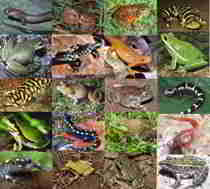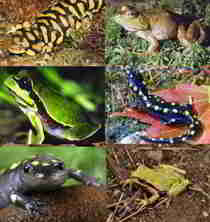Kansas State Amphibian
Barred Tiger Salamander
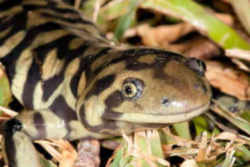
(Ambystoma tigrinum mavortium)
Adopted on April 13, 1994.
The Barred Tiger Salamander, (Ambystoma tigrinum mavortium,) was selected, during the 1994 legislative session, as the Kansas State Amphibian. The bill officially became a law on April 13, 1994.
In the Barred Tiger Salamander, (Ambystoma tigrinum mavortium,) the dark spots are larger than in the last two and tend to form the background color, while there are yellow bars or stripes that extend from the belly to the middle of the back, though these are irregular in form. In the south of this subspecies range it is a winter breeder, in the north an early spring breeder, migrating to ponds after heavy rains.
Kansas State Amphibian: Barred Tiger Salamander
Adoption of the Barred Tiger Salamander
The Barred Tiger Salamander project for Kansas State Amphibian began in March 1993. The idea originated in Mrs. Alice Potts' second grade classroom during a study of the five animal groups with back bones. That spring all the legislators in the Sedgwick County Delegation were contacted with a request to lend their support. Many responded in a positive manner but indicated it was too late to initiate legislation at that point in the session. The OK representative, Tom Bishop, agreed to introduce legislation in the House of Representative in the fall.
During the 1993-94 school year the entire OK School community became involved - students , staff, and parents. At the suggestion of Principal Judy George, the project became a part of the OK School Improvement Process. When the '93-'94 term began, the B.T. campaign was presented by Mrs. Potts to the OK staff. They embraced the idea enthusiastically. It became an exciting year of exploration and learning. The project provided numerous opportunities for cross curricular integration as students experienced the government process at work.
On March 8, 1994, Ms. George, Mrs. Potts, Mrs. Rita Rhodes, and four student representatives traveled to Topeka to attend a Senate Committee hearing. Mrs. Potts and the four students (Courtney Glasper, Betsy Hughes, Chris Obando, and Cheri Freund) testified before the Federal and State Affairs Committee on behalf of the Barred Tiger Salamander. A few days later, this committee approved the bill (SB#497) and sent it to the Senate floor.
The Senate passed the bill 39 to 1 and sent it to the House of Representatives. In the House the bill was not granted a hearing due to time limitations and leadership reluctance to deal with a bill of this nature.
Senator Mike Harris, representative from the OK area and bill sponsor in the Senate, came to our aid. He amended the salamander bill and attached it to HB#2811, an ostrich farming bill. This assured that the bill would be heard. On March 31, 1993, the bill passed 103 - 20! It was an historic day for OK School and for students throughout the state!!
On April 13, 1994, Governor Joan Finney hosted a signing party at Cedar Crest for the Barred Tiger Salamander Bill. All students and staff at OK and students from all across the state attended - approximately 1,000. It was a joyful day of celebration!
Characteristics of the Barred Tiger Salamander
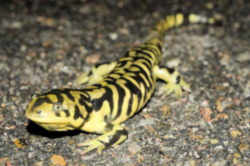
The salamander is 3" to 6" snout-vent length; to about 12-1/2" overall and has a robust body with 6 - 36 bright yellow or olive spots, blotches or bars on back and sides between front and hind limbs. Often with round spots or irregular blotches of black on light background, or yellow spots on black body color. Larvae with three pair of gills.
Diet
Any animal small enough to swallow such as insects, worms, fish, tadpoles, frogs, toads, salamanders and mice
Natural History
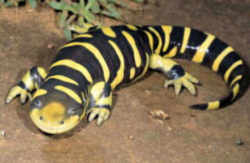
Like several members of its salamander family (Ambystomatidae), Tiger Salamanders exhibit facultative metamorphosis, whereby environmental influences stimulate larvae to develop into sexually mature adults with aquatic rather than terrestrial adaptations (Duellman and Trueb, 1986; Pough et al., 2001). This retention of larval characteristics (e.g., external gills, tail with fin margin) is accomplished through a developmental process called paedomorphosis; the form paedomorphosis apparently takes in salamanders involves neoteny, whereby the heterochronous development of the somatic tissues of immature animals proceeds apace slower than the development of the gonads and other components of the reproductive system (Pough et al., 1999).
Facultative metamorphosis is highly adaptive in arid regions where terrestrial conditions outside of the immediate vicinity of the breeding ponds
are inimical to terrestrial salamanders. Chihuahuan Desert populations of Tiger Salamanders are no exception, and thus terrestrial transformed adults
may be seldom seen in a region that supports a large but relatively unobvious population of neotenic adults and larvae in local cattle ponds and other
impoundments. Heavy rainstorms occasionally bring transformed individuals out onto roads at night.
Transformed terrestrial adults typically feed on insects and other arthropods. The larvae likewise feed on arthropods that live or fall into the water,
spadefoot toad (Scaphiopus) larvae, and each other. A neotenic "cannibal morph" (Rose and Armentrout, 1976) may also appear in populations; this form
consisting of individuals with larger heads, wider mouths, and more effective predatory teeth. Cannibal morphs eat a variety of vertebrate and invertebrate
animal prey besides other salamanders (Hammerson, 1982; Collins, 1982); the environmental cues that result in their appearance in Tiger Salamander
populations are uncertain, but have been tied to larval density (Collins and Cheek, 1983) and aquatic pathogens (Pfennig et al. 1991).
The salamander spend ends much of its time in caves, crayfish burrows, or even in the burrows of prairie dogs where it's moist and will emerge at night.
Reproduction:
Fertilization is internal by spermatophores; the courtship behavior takes place in water (see Arnold, 1976, for full description; summary in Duellman and Trueb, 1986). Eggs are laid in temporary ponds and hatch into aquatic larvae. Webb and Roueche's (1971) Jornada study indicated that egg deposition occurs when summer rains fill the pond, but may also occur in the spring and fall if sufficient rainfall occurs during these periods, and probably occurs on occasion throughout mild winters. In the Webb and Roueche's Jornada site, eggs are typically attached singly or in pairs to objects in the water (e.g., submerged twigs); the larvae at hatching were 9 to 10 millimeters in total length.
- sexual maturity: may be attained as larvae (neoteny) or after metamorphosis into adulthood
- breeding season: December - March after sufficient rain
- female lays 1000 eggs in 2 - 3 small clumps which are attached to sticks and weed masses along water's edge
- hatch in a few weeks as gilled larvae
Environmental/Global
- Habitat: As a species, this salamander occupies a wide variety of habitats ranging in elevation from sea level to over 10,000 feet and from boreal forest to desert scrubland. Found in prairies, forests, forest ponds, limestone streams.
- Distribution: Throughout Kansas and most of the southern Great Plains
Kansas Law
The law designating the barred tiger salamander as the official Kansas state amphibian is Section 73-2301 (Official amphibian of Kansas ) of the Kansas General Statutes, Chapter 73 (SOLDIERS, SAILORS AND PATRIOTIC EMBLEMS) Article 9 (STATE AMPHIBIAN) Section 73-2301.
CHAPTER 73. SOLDIERS, SAILORS AND PATRIOTIC EMBLEMS.
ARTICLE 23. STATE AMPHIBIAN.
73-2301. Official amphibian of Kansas. The barred tiger salamander (ambystoma tigrinum mavortium, Baird, 1850) being a strikingly
marked species, with robust body, and living in a range from the humid tallgrass prairie of eastern Kansas to the arid high plains at the western border,
is hereby designated as the official amphibian of the state of Kansas.
History: L. 1994, ch. 79, § 10; July 1.
Taxonomic Hierarchy: Barred Tiger Salamander
Kingdom: Animalia - animals
Phylum: Chordata
Subphylum: Vertebrata
Class: Amphibia
Order: Urodela
Family: Ambystomatidae
Genus: Ambystoma
Species: Ambystoma tigrinum
Subspecies: Ambystoma tigrinum mavortium
